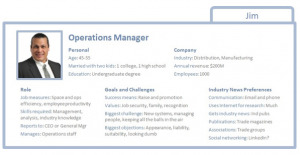Pillar Section 3: Developing Your Buyer Personas
Developing Your Buyer Personas
An ideal customer is a buyer that you want to replicate over and over and over again. “Ideal” is not a qualifier that can be superimposed; it is not who you aspire to be your best customers. It is quantifiably defined as those who have the most NEED, the most RESOURCES, and the most URGENCY for your product or service.
What is a buyer persona? A buyer persona is a semi-fictional representation of your ideal customer. In essence, it is a personality that you can use to evolve your trade show business strategy, communications and marketing around such that when in front of the right audience, they self-identify immediately. Just like a fish consuming the bait (and hook).
At MEET, we recommend three steps to discovering your ideal customer. Moving through these steps will leave you with a characterization that includes key attributes (in the B2B world) such as industry, market segment, revenue size, and level of stability.
(B2C attributes will look significantly different and include characteristics such as age, gender and income.)
Learn more about these three steps here.
 Next, you’ll need to determine how to apply these attributes to buyer personas. By “apply” we mean catalogue and create an archetype that will inform your trade show strategy plan. To ensure accuracy while retaining your ideal customers, we recommend setting up brief interviews.
Next, you’ll need to determine how to apply these attributes to buyer personas. By “apply” we mean catalogue and create an archetype that will inform your trade show strategy plan. To ensure accuracy while retaining your ideal customers, we recommend setting up brief interviews.
To learn more about how to use interviews to develop buyer personas and what questions to ask, check out this post.
Once you’ve completed your interviews, you’ll want to use this data to drill down on the demographics, goals, preferences, and interests of your ideal buyer, as well as any inefficiencies that challenge them i.e., “what’s keeping them up at night”.
In the B2B world, personal information may include compensation, past work history, and their role within the company both in terms of responsibilities and reporting structure. All this information will help you to craft an offer that speaks directly to their unique needs and to identifying more of “them”.
In the B2C world, your buyer persona will focus more on the customer’s frustrations and motivations, honing in on how she defines convenience and ease.
The tighter your buyer persona, the more effective your trade show strategy plan will be.
While target customers will inevitably shift over time as both your company matures and the market changes, maintaining a well-informed trade show strategy plan requires that you hone in on precisely who it is you are aiming to meet prior to each and every event you participate in.
Do you need help assembling your buyer personas? Contact MEET.
Using Buyer Personas to Inform Your Trade Show Strategy Plan
Every trade show strategy plan should be focused on at least one target customer, or what we refer to at MEET as a buyer persona.
Again, buyer personas are developed based on your existing knowledge, research, and conversations with customers, partners, and mentors. They represent a hypothesis based on the market you’re in for the purposes of entering a new market and therefore need to be tested.
Prior to exhibiting in any particular marketplace, it’s important to prioritize these buyer personas based on who is most likely to attend a given event. The first goal to set within your trade show strategy plan is to identify the two to three buyer personas that you are aiming to meet.
Informing your trade show strategy plan with buyer personas means using these profiles to determine which events to attend and how you will participate. The buyer personas become your “true north” which all strategies are aligned to.
Start by asking yourself these questions:
Does your buyer persona typically attend events that are focused locally, regionally, nationally, or internationally?
How does your ideal customer typically engage in events and with fellow participants?
Do they generally spend time listening to speakers and opinion leaders or do they spend most of their time on the floor with exhibitors and sponsors?
Answers to these questions about your buyer persona will guide your trade show strategy plan in terms of event selection and mode of participation.
 Finally, buyer persona data may inform your decision of whether to join industry groups or associations. Particularly for young companies in growth mode, participation in local or regional associations can help to develop strong customer density within a region, industry, or customer type that will help your company grow faster and more efficiently.
Finally, buyer persona data may inform your decision of whether to join industry groups or associations. Particularly for young companies in growth mode, participation in local or regional associations can help to develop strong customer density within a region, industry, or customer type that will help your company grow faster and more efficiently.
Using Buyer Personas to Guide Your Event Strategy
Selling at trade shows that you’ve hand selected based on buyer persona data offers an array of opportunities for customization. You may use buyer personas to determine how you will participate in the event—as a speaker, exhibitor, or sponsor, as well as where is the optimal place for your booth on the show floor.
Buyer personas are also critical to informing your offer strategy. Your booth offer must speak directly to the prospects you are aiming to attract. For example, at an event of 10,000 people, your buyer persona data may project that 50 to 200 prospects will be in attendance. Your goal in designing your offer should be for 9,950 to 9,800 people to walk by your booth without stopping.
Only true prospects should be attracted to your offer.
![]()
In essence, you want to design your offer to speak directly to your ideal customers and only your ideal customers. The more shiny objects, be they candy, pens or “win an iPad” offers that you have in your booth to attract general attendees, the less time and space you will have to engage with your prospects.
See our post on why overcrowding your booth with free gifts can be detrimental to your trade show strategy plan goals here.
Click here to download the full report: How to Maximize ROI with a Trade Show Strategy Plan
About
MEET (meetroi.com) helps international B2B growth companies soft land and scale in the U.S. through trade shows and in-person events. MEET’s processes help its clients ramp-up sales quickly and maintain a steady stream of high-quality prospects going forward. Contact Bill Kenney for a free, no-obligation consultation bill@meetroi.com or +1 (860) 573-4821.
